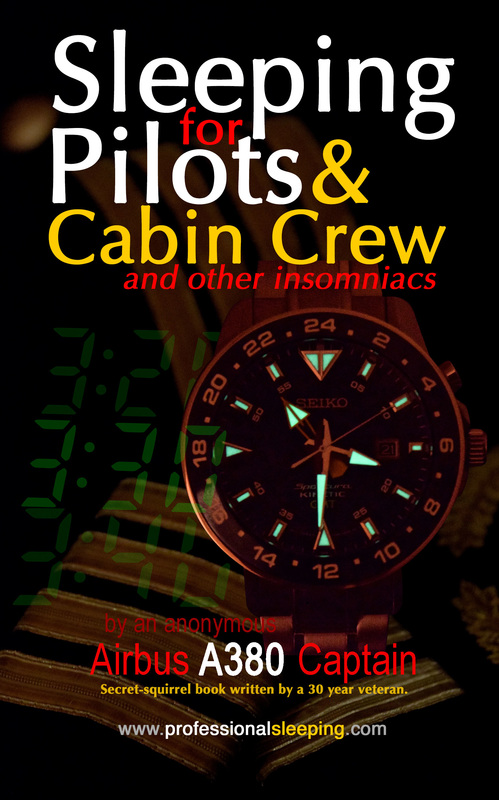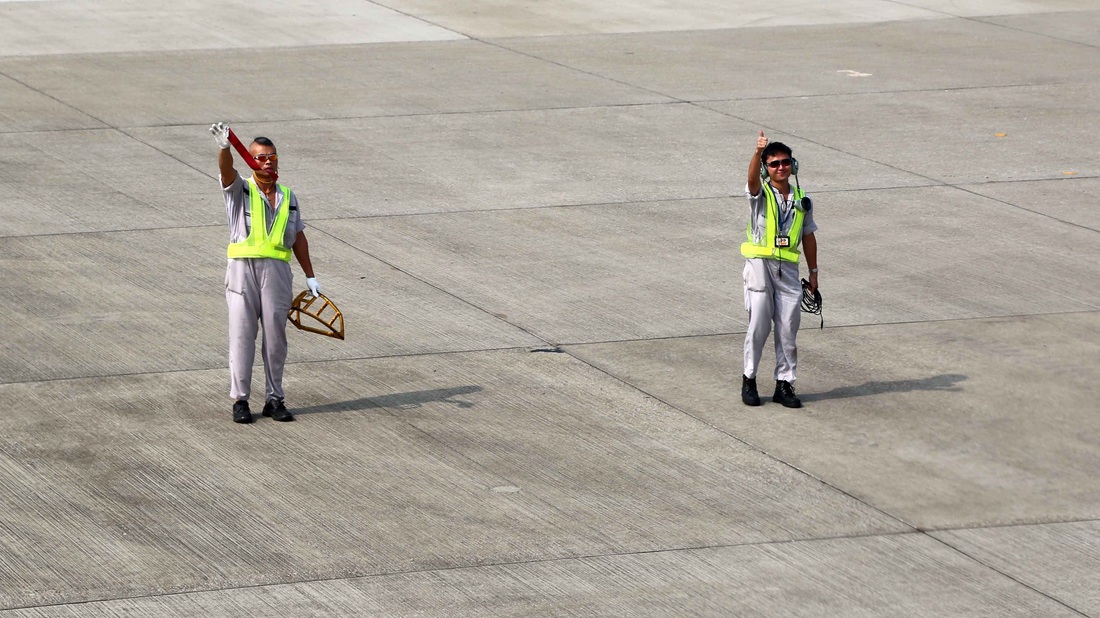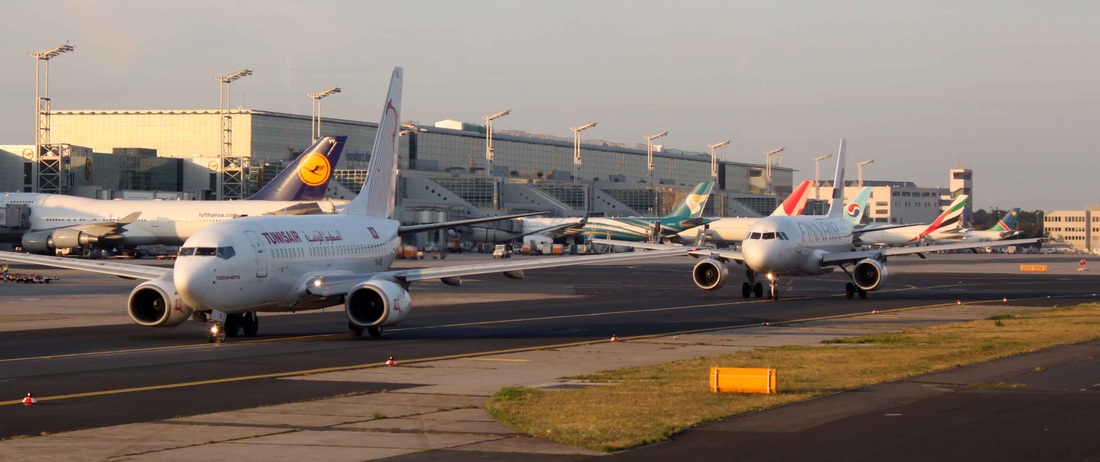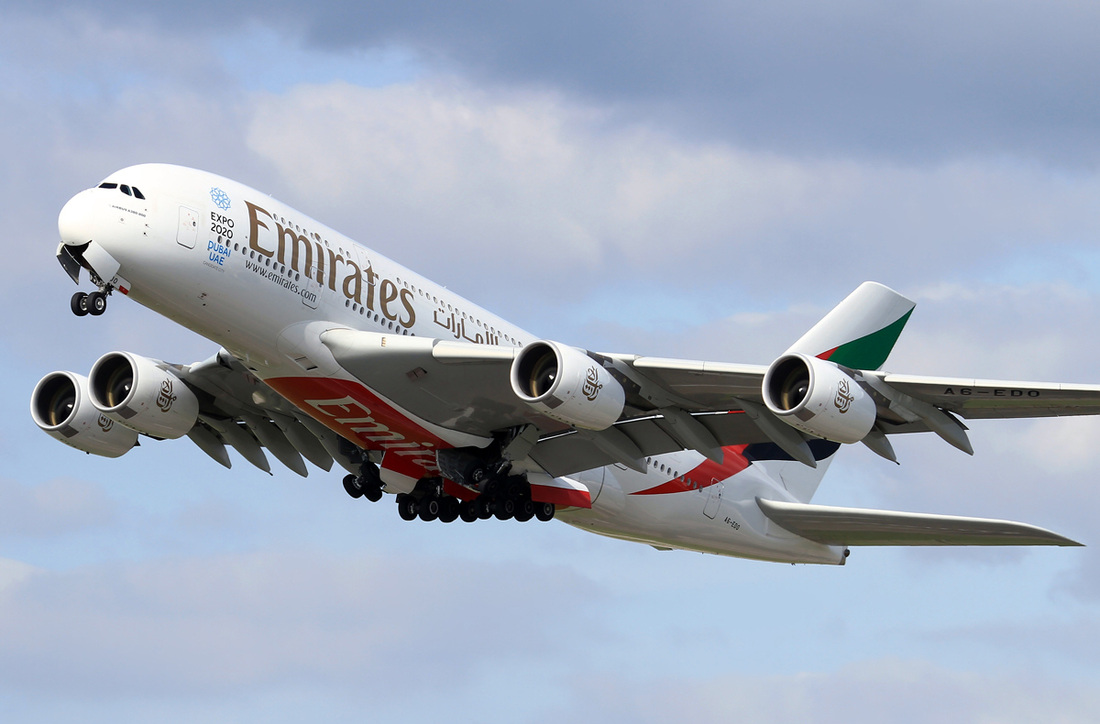|
If you ever depart from or arrive at Heathrow Airport in London, you will see an Emirates Airbus A380 model. The 45-tonne model was constructed after the Middle Eastern carrier took over the advertising site from British Airways in 2008.
Built by California-based Penwal Industries, the model 24m long with a wingspan of 26m – a one-third scale replica – and comparable in size to a Bombardier CRJ200, and never fails to impress. The model is built from glass-reinforced plastic covering a steel frame. It was flown from Ontario in California to Heathrow by a chartered Antonov An-124, operated by Russian carrier Polet. Once in London a mechanical ramp, brought in specially from Germany, was used to unload the 10 components. The Emirates A380 replaced the British Airways Concorde Model, which is now placed at Brooklands Museum.  QANTAS A380-842 "David Warren", seen arriving from Singapore and on the way to the parking gate at Heathrow. David Warren (20 March 1925 – 19 July 2010) was an Australian scientist, best known for inventing and developing the flight data recorder and cockpit voice recorder (also known as FDR, CVR, and "the black box").  Wedding cake and card given by Emirates airline cabin crew on flight to Dubai from London. Great flight...photos on their camera came out better (yes, hard to believe that a PHOTOGRAPHER could not take his own photo!)...never had 12 crew surrounding my seat...what a celebration!: Photo Copyright Navjot Singh I first met James on an Emirates A380 flight from Dubai to London Heathrow (Callsign ‘EK003 heavy’- click here to view the review of that flight) in 2011. He was our Senior First Officer and was kind enough to take a few photos for me from the flight deck using my camera (my camera was allowed in, but not I!). We had an amazing crew on that flight, and the senior purser was a good bloke. Upon hearing that I was a photographer and journalist, he replied “Oh, our senior pilot is also a photographer and author- let me speak to him and see if he can lend you his book”. The guy gave me his book for the whole flight…best in-flight reading I have ever done! After we landed at a windy Heathrow, the senior purser (who somehow also doubled as a good salesman), asked me “So, what do you think? Would you like to buy it?” I burst into laughter….I thought it was a free gift from James! Ever since that flight, we have been good mates. I can say that he comes across as a very friendly and customer-focused person- which is a rare to find in the aviation industry these days. Reading his blog posts and his Facebook posts, you get the feeling that he is a true aviator and not just a pilot- he calls his planes girlfriends…I mean, you can’t really get much more love out of your job than that! He makes you wish you were a pilot, even if you are not into aviation and even if you have no love for planes whatsoever! James has always provided me with great advice about flying and I have cherished that advice. We met again in Dubai in 2015. This time he was preparing for his simulator test for his command course on the Airbus A380. It was at that time that he told me of his retirement plans. I was quite sad and surprised to hear it. James’ last flight, EK407, was on the 24th of September from Melbourne (MEL) to Dubai (DXB) on aircraft registration A6-EDY, arriving early in the morning in Dubai. I cannot begin to imagine what he must be going through at this time, knowing that he will never fly ever again. His career has been nothing short of an exemplary one for those who want to enter the challenging but rewarding world of aviation. He will be writing books in his retirement on subjects related to aviation (while downing a few well-deserved daiquiris in Boracay, no doubt!). Click here to read a review I wrote for one of his books in sleeping for pilots and other insomniacs! In his own words, just before this last commercial flight out of Melbourne for Dubai, the great Melbournian said on Facebook: “They say pilots only love the plane they're flying ... And they remember only two flights, the last one they did and their first solo. Thanks, Peter Nelson, for sending me solo in 1985 ... Will never forget it!”. After a remarkable career of thirty-one and a half years that many can only dream of having, I am sure he will be yearning to fly again soon! Mate, you are really an inspiration to many and it has been an absolute pleasure to know you as a mate. Here’s cheers to a very well-deserved and happy retirement! Below is a recording of James' interview on Melbourne's Radio 3AW with Darren James
When it comes to writing books, it is always the original ideas that win, and this is one that most people have been waiting for someone to write about. This book is very well-researched, well-written, and thoroughly deserves to be read and reviewed by mainstream global media outlets. The author provides the readers with factual information and very useful messages on a subject that is crucial to those who take us safely from A to B. The author does this all with an entertaining and witty song throughout. It is a pleasure to read what he has written - so much more beautiful and interesting than anything else that you will find in any aviation related magazine.
The only problem here is that I, or anyone for that matter, sadly cannot reveal the identity of the author. Which is a shame, because when you read the amount of excruciating detail that he has gone into in laying out the crude fundamental reasons of why pilots and cabin-crew fail to get a good night sleep, only then you end up realising how fortunate those are that are reading this subject. I appreciate that the author provides interesting facts with a winsome sense of fun, and sometimes with silly-clever interludes, but on the whole there is a lot of pertinent information about a serious subject at hand. It goes without saying that for a demanding job as being an airport pilot (and also cabin crew), getting the license and qualifying to get the job is only the first step in something that can be a rewarding career. However, the real challenge is to fight off the fatigue that comes with the job (it can make or break a career- and that’s one of the many reasons why you need a Class 1 Medical to be an airline pilot). For most passengers, a single 12-hour flight can be enough to put off flying for a while- imagine doing that day-in day-out for the rest of your career. Pilots who fly internationally have to deal with jetlag and the weird times at which they land/take-off all the time, and they have to be fully mentally and physically fit for that. It is not easy by any means. Weird sleep patterns can have a disastrous effect on your body. In many cases, crew only have up to 48 hours of layover time before they turn-around and fly again. Low-cost and regional crew also have to deal with such challenges (though not with jetlag), but imagine starting at 3am and finishing at 1am the following day without a rest and aircraft delays, and then have to start again the following day- that’s the life of a low-cost airline pilot. Many pilots and cabin-crew choose to find various ways to fight of their the pressures of the job - binge drinking (not everyone, of course), sleeping tablets, anti-migraine tablets, chain smoking etc. are all well-known habits that are practised in the industry (it is very difficult to get into and stay in the industry and very easy to get out of the industry). But how do you effectively end up enjoying a good night sleep on a layover? How do you manage to do that, especially if you are working for a not so well-known airline, where they stick the crew up in the cheapest hotel possible, complete with bed bugs and noisy neighbours? Well, thankfully this book lifts the lid on a subject which everyone in the airline industry wonders about, but nobody has had the time to write about. I think every pilot, whether they are a trainee, experienced, a Top Gun… and even if they have flown Air Force One for the U.S. President, should get a copy of this book, grab a freshly brewed coffee (preferably not the one you get on planes), and cherish every word. In actual fact, this book would come handy to other insomniacs, especially doctors, nurses, night-time police helicopter pilots and so on. The highly respected and experienced author works for a major airline (cannot give name) as an Airbus A380 Captain, and he has been all over the world and in all kinds of situations for the past 30 years – in other words, he’s seen and done it all from Dhaka to Guangzhou to Malta to Zanzibar and in other far flung places. Click here to order this book from Amazon createspace for only $15.9 Click here for the book's website The Aircraft Dispatch Engineer (left hand side), stands level with the flight deck side window, but clear of the spinning engines' intakes (don’t want to get sucked in!), and holds up the nose gear steering pin for the benefit of the pilots to see before waving goodbye. He is not saying “Chocks away, chaps!”, but the meaning is something on similar lines. Attached to the pin is a long red tape with the words 'Remove Before Flight' written in large white letters. The pin is necessary to prevent un-commanded movement of the nose wheels during the pushback phase from the aircraft stand. If the pin is not removed then the gear will not retract, which, in the past, has resulted in embarrassment for pilots in a number of airlines (you can Google it!). It means dumping enough fuel to prevent an overweight landing, then returning to land. This can cost an airline millions of dollars (US), cause unnecessary delays, cause extra stress/pressure to the pilots and make a lot of passengers unhappy and worried- none of which any airline or pilot wants. Aircraft can usually take-off with a much greater weight than they can comfortably land. So, for example the Airbus A380 (and I believe the Boeing 787, too) can always land at its maximum take-off weight in an emergency, but it’s very stressful on the brakes and hence can cause tyre bursts.
Dubai-based Emirates Airline placed an order for 150 of Boeing's new 777 mini-jumbos (nicknamed 777-X), in a $76bn (£47bn) deal at the 2013 Dubai Air Show. These will be a combination of 35 Boeing 777-8Xs and 115 Boeing 777-9Xs; plus 50 purchase rights. It is the single largest aircraft order by value in the history of US commercial aviation, creating and supporting an estimated 436,000 jobs in the US. Emirates currently operates 131 Boeing 777s and has a further 214 Boeing 777s on order. The 777-X, which has FOLD-UP carbon fibre wing tips will be delivered in 2020 (without the bendy wings, the wingspan is about the same as the Airbus A380).
Emirates has also ordered FIFTY Airbus A380s, in a deal worth $23 billion. The airline is already the biggest customer of the A380. So where will they be parked? Dubai is a tiny place, and indeed, so is it’s airport. The answer is going to be ‘Dubai World Central - Al Maktoum International Airport’. The airport is planned to become the world's largest passenger and cargo hub, ten times larger than the current Dubai International Airport which covers an area of 29 square kilometres (7,200 acres) and Dubai Cargo Village combined. One terminal is going to be for ALL THE OTHER AIRLINES except Emirates (& Qantas Airways two daily appearances). The latter two will enjoy having Terminals A, B & C to themselves. When they move to DXB World - it'll be in one hit, in about 2020 - when the first 777-X arrives. Meanwhile, all the freight aircraft and the VIP aircraft will be sent to DXB World before the runway works next year (DXB World is going to have FIVE runways). So, now you know where they’re gonna park the 140 A380s, 150 777xs, 100 777s and 70 A350s as from 2020. While the aviation industry is suffering financially in the Americas and Europe, it is booming in the Asia Pacific and Middle Eastern regions. Huge airport construction projects are well under way in cities such as Shenzhen (new airport terminal will open on 28th November), Doha, Dubai, Mumbai, Delhi, Kunming, and many others (mostly in China and the Middle East). While most of the legacy European airlines (BA, Air France, KLM, Iberia, Alitalia, TAP, SAS, Finnair, and Aer Lingus), are going through an 'economic sufferage', Germany's national flag carrier, Lufthansa German Airlines, can be proud that it is one of the few airline companies in the Western hemisphere that is doing well. News earlier in London that the new UK Government is thinking of scrapping plans for the third runway at Heathrow, the world's busiest international airport, will have wide repercussions for airline manufacturer Boeing, who have bet on the 'more flights more often' mantra in developing the 250-330 passenger 787 Dreamliner.
With no ability to increase aircraft movements the prize must go to Airbus who bet on the 526 seat Airbus A380-800 (nicknamed the 'Super Jumbo'). Lufthansa was the 2nd European airline to operate the A380, and has 10 aircraft currently in service operating on high density routes such as Beijing, Johannesburg, and Tokyo. On December 6, 2006, Lufthansa placed an order for 20 Boeing 747-8I airliners (the longest aircraft in the world), becoming the launch customer of the type. The airline currently has 9 aircraft in service, each with 386 seats; and has a further 10 on order. I had a chance to fly on this relatively brand new aircraft (which first flew on June 1st 2012). Lufthansa is the only airline that currently flies the passenger version of the Boeing 747-8i. Korean Airlines, Air China, and Arik Air have placed some orders for passenger version of this aircraft. Since it's introduction 6 years ago, the Airbus A380-800 has become a regular visitor to Heathrow, with Emirates, Malaysia Airlines, Qantas, and Singapore Airlines all flying this beast into London. Soon British Airways will start flying the A380 from LHR.
She's not as beautiful as the Boeing 747, however two things do stick out about the A380....she is remarkably quiet, and her enormous size (wingspan and length of fuselage both just under 80 meters)...which means that while you may be having a chat with your friend in a cafe, she will surprise you while gilding past quietly in the background..it's gets me every-time...almost as if a huge whale is in the sky... Wanna know what's she's like inside? Here, read THIS, and if you ARE flying First Class on her, then try the showers (can't beat a shower in the sky..) Seen here, Dwayne Malone of Emirates takes her out of Heathrow...back to Dubai. British Airways get their first Airbus A380-800- that's SIX years after Singapore Airlines became the first carrier to fly this SuperJumbo (inaugural flight was on the 25th of October 2007- and 9 airlines already operate this aircraft)....and so you wonder why the UK media reacts as if they've never seen this plane before....(the same thing will happen when/IF Virgin Atlantic Airways get their first A380 aircraft- Virgin was one of the first carriers to order the A380, and was originally due to take the model in 2006; but that's been pushed back to 2018).
When passengers arrive or depart from London's two major international airports, Heathrow and Gatwick, they will notice that the aircraft models that are displayed as welcoming adverts are in fact not representative of any of the British airlines.
On the 30th of March 2007, a scale model of Concorde which had the pride of place at Heathrow Airport's entrance for 16 years was sadly removed, and replaced in 2008 with an Emirates Airlines A380 aircraft model. British Airways had decided not to renew the £1.5m annual rent to advertise on the roundabout at the gateway to the London airport. Instead, Emirates Airlines, the major carrier of the United Arab Emirates, poached the prime spot with a six-year deal to advertise on the site. Meanwhile at Gatwick Airport, Turkish Airlines have partnered with Eye and Gatwick Airport to suspend a scale model aeroplane inside the airport terminal. The Boeing 777-300ER aircraft, situated in Gatwick’s North Terminal check-in measures 6.1m in length with a wingspan of 5.1m. The 124kg structure created by Leading Models will be suspended from the check-in ceiling until August 2013. Back in the 1970s, 1980s and 1990s the airport billboards at British Airports were thronged with national pride such as BOAC, British Caledonian (remember them?!), British Midland, Virgin and so on. With the change of the times, it's the Middle Eastern and Asian carriers who seem to have the money (China Southern Airlines have huge billboards outside Terminal 4 at Heathrow). So the question is if there any chance that we may ever see British carriers advertising their airlines at British airports? As we cruise from Dubai to Heathrow in the Emirates A380 aircraft, the afternoon Europe-bound fleet heads over the Turkish Peninsula with the sun's bright rays hitting straight at us. Once past Turkey, in Eastern European airspace, as we climb to 39,000 feet and start saving fuel, the Captain took some time to talk about the flight dynamics (you can just make out the Senior First Officer's hand on the left). The A380’s faster cruising speed, 0.85 Mach, is faster than most aircraft. (photos taken by James Nixon)
|
Get in Touch:LIFE MATTERSHere I share my thoughts
and experiences during my travels, and how some things have affected my life as an expat and world traveller. Travelling is about capturing that moment in life. Every word, view and opinion on this page is that of Navjot Singh - except where indicated. The most recent is at the top. Scroll down to read the archive. Or search using CTRL+F (COMMAND + F) and enter a keyword to search the page. Just some of the stories you never heard before. The NAVJOT-SINGH.COM web blog is separate to this web site....Click blog, which may not be visible in some countries due to local firewall restrictions, so in those cases this weblog may be read. The weblog also includes some of my press trip reports- most of which are not published on the official blog because of copyright issues. The weblog also contains articles that may be associated directly with a PR trip for a country, airline or a hotel. These are PR reviews done in relations with various companies. If you are an investor or a trend watcher then you may find this website useful as investing has a lot to do with personal observations and finding the ideal trend or next big thing. The average human on the street frequently knows far more about the state of the economy than politicians, university professors, subject matter experts, and financial analysts who seldom travel, or if they do so, only from one hotel to another hotel! The pulse and vibrancy of an economy is nowhere more visible than on a country's streets. All photos and words are © Navjot Singh unless stated. Photos taken by others or by agencies are appropriately copyrighted under the respective name. No photo or word/s may be taken without the prior written permission by the author (i.e. Navjot Singh). All Rights Reserved. Archives
April 2024
Categories
All
|























 RSS Feed
RSS Feed







